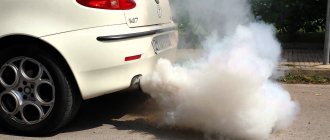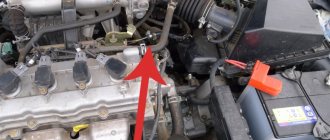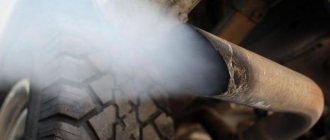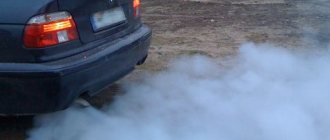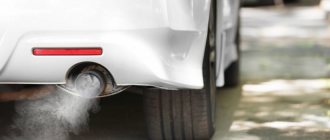Smoke of different colors can come out of the exhaust pipe of a diesel engine: black, blue, gray, white. Each of these shades is clearly distinguishable when exhausted. Car owners are often interested in why a diesel engine smokes.
For high-quality control over the functioning of the power unit, it is necessary to conduct a thorough analysis of the shades and colors of the exhaust gases. The color of the diesel engine exhaust provides comprehensive information about the condition of the engine components and parts.
This allows you to eliminate malfunctions in the systems and components of the power unit, check the condition of the parts of the cylinder-piston group, gas distribution mechanism, eliminate failures of nozzles, fuel injection pump elements, etc.
Main signs of normal operation of a diesel engine
White smoke from the exhaust pipe of a diesel engine is a product of combustion of the air-fuel mixture, which is in a gaseous state. With optimal settings, a warmed-up diesel engine does not smoke. Normal engine operation is accompanied by the release of white water vapor, noticeable in winter when the ambient temperature is low.
The appearance of shades in diesel exhaust gases indicates a malfunction in the power unit. The color of the exhaust gas can be in various options:
- white-gray;
- gray;
- grayish blue;
- black smoke with soot.
Prevention of "disease"
- check the antifreeze level in the expansion tank. Both using sensors and directly looking at the tank.
- antifreeze should not go away and change greatly in volume, but it needs to be updated - ideally, at least once a year
Even on cars with decent mileage, adding coolant is required little and rarely. If you need a new dose of antifreeze before each trip, your next destination is a service center. Preferably, official, with smart specialists and equipment. Because it's a serious matter.
The antifreeze has “evaporated” again - urgently go to the service center!
Are you waiting for a sign from above to help you realize that you can’t delay any longer?! Here he is! The faster the symptom of white smoke from the exhaust pipe is cured, the “less bloodshed” (less expense and nerves) you will get away with.
It is better, of course, that such serious problems do not happen in your auto history. So take care and love of your car and it will love you back.
This is interesting: How to change a low beam bulb on a viburnum
How to distinguish white smoke from water vapor
To determine what quality of smoke comes out, you need to bring a white sheet of paper closer to the outlet of the pipe of a warm engine. Water stains quickly evaporate, leaving the paper clean. Bold marks on the paper indicate the presence of oil inclusions in the exhaust.
Smoke containing oil fragments is thicker and has a characteristic burning smell. When oil is present in the exhaust gases, increased consumption of engine oil is observed.
Smoke from the muffler pipe with a bluish tint
Some motorists confuse blue smoke with white smoke and believe that they are the same thing. Blue smoke is always accompanied by increased oil consumption and indicates a malfunction of the cylinder-piston group. Reasons for the appearance of bluish exhaust from the pipe:
- wear, scoring in the cylinders;
- wear, breakage of piston rings;
- burnout of pistons;
- hardening of valve stem seals.
The partitions between the piston rings on the pistons may also burst, and the valve guides in the cylinder head may wear out. When blue smoke comes out of the chimney, it is often accompanied by knocking in the engine, and with such signs, you should not continue to operate the car; a major overhaul is required.
Related articles:
- Engine detonation - causes, solutions Modern cars are equipped with four-stroke gasoline and diesel engines, which were developed back in the late 19th century, despite significant progress in
- The engine does not start when the starter clicks: the main reasons, diagnostics, troubleshooting. A car’s unexpected refusal to start can upset any car owner, especially if you need to go somewhere urgently, and it’s difficult to figure out what the problem is right away. When
- Causes and signs of catalyst clogging, diagnostics, solution to the problem The catalytic converter (or another name for the catalyst) is installed on all modern cars, designed to clean exhaust gases from harmful impurities, reduces the level
Exhaust gas formation process
Diesel fuel, being under high pressure, is injected into the cylinders through a special sprayer - an injector. The diesel fuel is sprayed into small fragments in the cylinder. The smallest particles of diesel fuel are heated in the combustion chamber and actively evaporate.
The operation of a four-stroke engine takes place in several stages:
- Obtaining a sprayed portion of fuel at a given time both at idle and when operating under load, when the cylinder piston is in the upper position, i.e. at the moment of compression.
- Self-ignition of the air-fuel mixture due to compression and high temperature.
- Complete combustion with maximum return of useful energy to the piston.
- Exhaust gases exiting the cylinders.
Causes of white smoke
When warming up a cold diesel engine, the release of white smoke is normal, since this is water vapor formed during the evaporation of condensate formed from the air while the car is idle. Some moisture pours out of the exhaust pipe when the engine starts, the rest of the water evaporates.
As all parts of the exhaust system warm up, moisture and steam completely disappear. In winter, the release of steam is longer and more intense due to the slow heating of components and parts.
White smoke appears for the following reasons:
- Increased humidity of components and parts of the exhaust system when warming up.
- Inadequate combustion of diesel fuel in cylinders.
- Faulty glow plugs.
- Insufficient compression level in the cylinders.
- The flash in the combustion chambers occurs with some delay.
- Failure of the fuel pump plungers and bushings.
- Penetration of coolant into the engine cylinders.
- Presence of condensate in the exhaust system.
How to check the thermostat
Very often, the cause of engine overheating is a faulty thermostat. The valve does not open and does not allow the coolant to flow in a large circle, as a result of which the engine gets very hot. Checking the thermostat is easy, but to do this it must be removed from the engine. We check as follows:
- take a small metal dish;
- pour water into it;
- place a thermostat in the container;
- put the pan on the fire, you can place an electric boiler in the water;
- heat the water.
The dangers of incomplete combustion of diesel fuel
Partial combustion of diesel fuel results in a smoke-white color. An untimely flash of air-fuel mixtures in the cylinders leads to the release of whitish-gray gas, which did not have time to fully push the piston and ended up in the exhaust pipe.
In working diesel engines, this happens when starting the engine in winter. The temperature in the cylinders is not sufficient for self-ignition, the diesel fuel evaporates and the mixture does not burn completely. This is not a defect, since the smoke completely disappears as the engine heats up.
A serious deviation from the norm is characterized by the appearance of a white-gray exhaust when the engine is warm. Here, self-ignition is observed with a delay due to untimely supply of diesel fuel by the injectors, but the engine temperature at the same time has a sufficient operating value.
If the injectors supply and spray fuel without delay, but white-gray smoke is still released, the air-fuel mixture does not burn completely due to a decrease in temperature in the cylinders due to poor quality glow plugs, a decrease in pressure levels, and defects in fuel pump parts.
These malfunctions lead to the following problems:
- difficulties that arise when starting the power unit, both cold and warm;
- the appearance of a tripping effect in a diesel engine;
- engine instability at idle and under load;
- drop in power unit power;
- deterioration of acceleration dynamics;
- increased fuel consumption;
- decreased engine response to the gas pedal.
Injector malfunction
It's no secret that the quality of diesel fuel sometimes leaves much to be desired. If the car often runs on low-quality diesel fuel, the service life of the injectors is greatly reduced. Clogged channels are one of the main problems of diesel units. Also, the operation of the injectors is affected by factors such as wear of the nozzle or insufficient pressure of the injection elements.
Due to improper operation of the injectors, little diesel fuel may enter the cylinders, or it will be poorly atomized. In both cases, the combustion process, and therefore the operation of the motor, will be disrupted. And since parts wear unevenly, most often the injectors spray fuel differently. Therefore, the cylinders also do not work the same way. Eventually, the driver will begin to feel the vibration characteristic of a revving engine. Therefore, experienced drivers advise changing diesel injectors every 150 thousand km.
If the engine seizes up, then the only way to identify a non-working injector is by moving it to another cylinder. If after this “manipulation” the cylinder refuses to work, then the problem is in the injector.
Remember that repair or cleaning of injectors in this case must be carried out in conjunction with adjusting the injector and checking the operation of the injection pump.
What is the effect of coolant entering the diesel combustion chambers?
When liquid from the cooling system enters the combustion chamber of a heated diesel engine, an exhaust saturated with thick white smoke appears from the pipe. The color of the smoke may change from white to gray as the antifreeze burns. The components that make up the coolant affect the color of the exhaust gases. The density of the smoke depends on the ambient temperature; in cold weather, the exhaust has a thicker consistency.
The water in the antifreeze actively evaporates, hitting the hot parts, and comes out of the pipe in the form of abundant fog.
The diesel engine especially suffers from this malfunction: diesel fuel becomes more saturated with sulfur, which leads to the formation of a colorless gas with a suffocating odor - sulfur oxide. When operating under such conditions, the service life of a diesel engine sharply decreases due to the rapid failure of its elements.
Filters
You know, the last reason could be faulty (clogged) engine air filters. I also thought that this was not possible - but it is a fact! The thing is that there is less air (dirty filters do not allow it to pass), but there is more fuel, and the “smoke” increases. But here, not only white but also black exhaust can appear. But this is a topic for another article, be sure to follow our blog.
In the end, I want to say - if you have such a “whitish fog” effect in winter, the fluid level does not drop, then this is normal! You shouldn't even pay attention to this.
I hope you liked the article, if so, then tell us about us on social networks, this is the biggest reward for us.
( 53 votes, average: 4.45 out of 5)
